Bromelioideae
Bromelioideae is a subfamily of the bromeliads (Bromeliaceae). This subfamily is the most diverse, represented by the greatest number of genera with 33, but the fewest species with 865. Most of the plants in this group are epiphytes, though some have evolved in, or will adapt to, terrestrial conditions. This subfamily features the most plant types which are commonly cultivated by people, including the pineapple.
| Bromelioideae | |
|---|---|
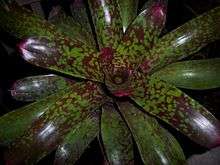 | |
| Neoregelia Aztec | |
| Scientific classification | |
| Kingdom: | Plantae |
| Clade: | Tracheophytes |
| Clade: | Angiosperms |
| Clade: | Monocots |
| Clade: | Commelinids |
| Order: | Poales |
| Family: | Bromeliaceae |
| Subfamily: | Bromelioideae |
Description
The foliage in most Bromelioids grow to form a rosette where water is caught and stored. Their leaves are usually spined and they produce berry-like fruits in their blooms. These plants contain an inferior ovary.
Genera
The 33 genera are:
| Image | Genus | Number of living species |
|---|---|---|
| Acanthostachys | 2 species | |
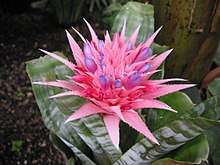 | Aechmea | 255 species |
| Ananas | 2 species | |
 | Androlepis | 2 species |
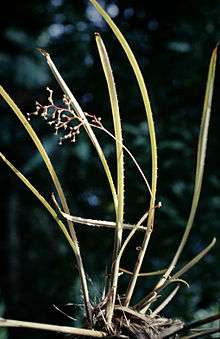 | Araeococcus | 9 species |
 | Billbergia | 64 species |
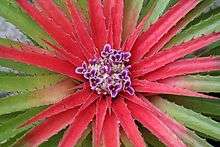 | Bromelia | 56 species |
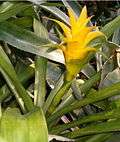 | Canistropsis | 11 species |
 | Canistrum | 13 species |
_2-03388.jpg) | Cryptanthus | 63 species |
| Deinacanthon | 1 species | |
_(39586155641).jpg) | Disteganthus | 2 species |
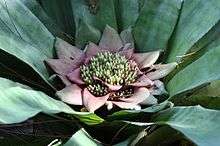 | Edmundoa | 3 species |
| Eduandrea | 1 species | |
_001.jpg) | Fascicularia | 1 species |
| Fernseea | 2 species | |
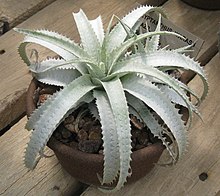 | Forzzaea | 7 species |
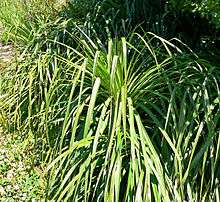 | Greigia | 33 species |
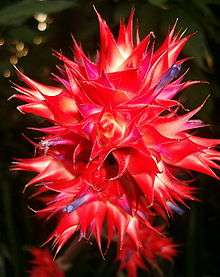 | Hohenbergia | 56 species |
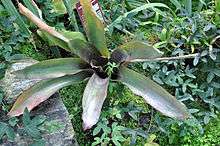 | Hohenbergiopsis | 1 species |
 | Lymania | 9 species |
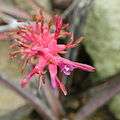 | Neoglaziovia | 3 species |
 | Neoregelia | 112 species |
| Nidularium | 45 species | |
 | Ochagavia | 4 species |
 | Orthophytum | 53 species |
 | Portea | 9 species |
| Pseudaechmea | 1 species | |
 | Pseudananas | 1 species |
 | Quesnelia | 20 species |
| Ronnbergia | 14 species | |
_mcvaughii_(9301955053).jpg) | Ursulaea | 2 species |
| Wittrockia | 6 species | |
gollark: Also, that's not blackmail.
gollark: There's a test under account settings somewhere.
gollark: Also, an admin called gollark.
gollark: Also, we need a #meta.
gollark: Er, it's a hype squad thing.
References
- BSI - Bromeliad Info - Taxonomy
- Bromeliads
- LUTHER, H. E. (2008) An Alphabetical List of Bromeliad Binomials, Eleventh Edition The Marie Selby Botanical Gardens, Sarasota, Florida, USA. Published by The Bromeliad Society International.
| Wikimedia Commons has media related to Bromelioideae. |
This article is issued from Wikipedia. The text is licensed under Creative Commons - Attribution - Sharealike. Additional terms may apply for the media files.